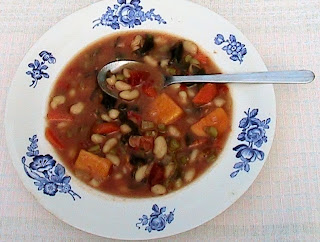Black eyed peas came from Africa with the slaves who planted, cared for, and cooked the black eyed peas along with pork fat as their own food. The black eyed peas are legumes full of vitamins, potassium, calcium, and iron.
 The black eyed peas have become the symbol for good luck and prosperity and as such are the first food to be eaten on New Year's Day in the Southern part of this country.
The black eyed peas have become the symbol for good luck and prosperity and as such are the first food to be eaten on New Year's Day in the Southern part of this country. The peas must be eaten with collard greens (or cabbage) that represents green money and cornbread that represents gold. To take this a step further to ensure good health and wealth, these foods are to be eaten with stewed tomatoes.
To Cook Black Eyed Peas: I planted black eyed peas as a cover crop a summer ago, harvested and shelled the peas, blanched them and put them into the freezer. For this New Year's Day, I cooked two (2) cups of peas in slightly salted water for two hours.
To dress up the black eyed peas, I stir fried a few slices of bacon, half an onion (diced), a stalk of celery (diced), and for added color I also tossed in some green pepper (diced). Finally, I added stewed tomatoes to the rest of the stir fried vegetables and added the black eyed peas to the mix.
To Cook Collard Greens: From the garden, I picked the collard greens, de-veined them, and chopped them up. For flavoring, I cooked the greens with smoked hog jowls that I bought from the country store up the road. I cooked the greens for a good two hours: this is roughage! I served the collard greens with the water melon rind pickles that I made last summer.
To Make Cornbread: I followed the recipe for Southern Cornbread on the Martha White's package for Self-Rising Corn Meal Mix. It came out with a nice golden color.

Sweet Iced Tea: To continue in the Southern tradition, I served Iced Tea with the peas, the greens, and the cornbread. (Still waiting for the pork chops). I boiled a quart of cool water and then poured it over five (5) tea bags to steep for five (5) minutes.
I filled up my tea jar with two trays of ice, poured a cup of sugar over the ice, and then added the freshly hot brewed tea. (Some Southerners add a pinch of baking soda into the tea that supposedly will take away bitterness in the tea if steeped too long.)
Sheridan Alexander has written a delightful article about the New Year's tradition. I Goggled Black Eye Peas for New Years. Thanks, Sheridan, for the information.
Wishing you a Happy and Prosperous New Year.
Thank you for visiting my blog.





































